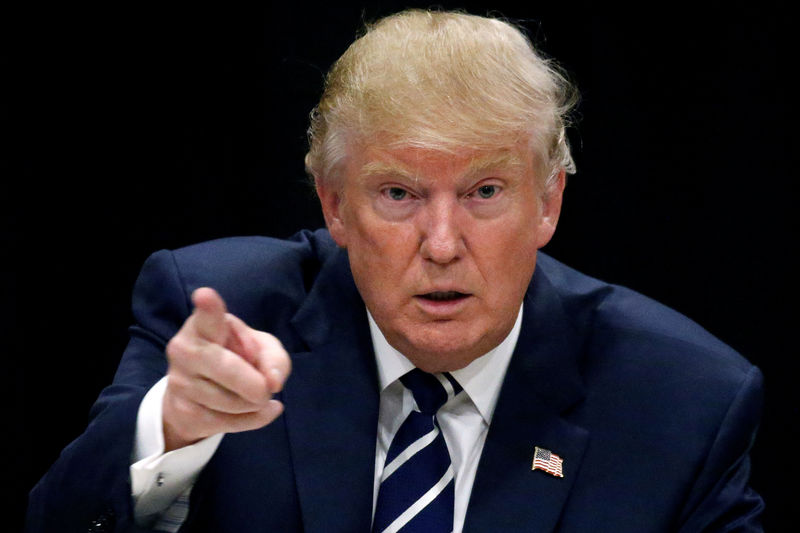Investing.com – Top 5 things that rocked U.S. markets this week
1. Dow Jones: ‘7’ Is the Magic Number
Energy stocks led the Dow Jones to its seven-straight daily win on Friday, helping the index turn positive for the year, following President Trump’s decision to dump the Iran nuclear deal.
The last big wave of notable earnings that rolled through this week also kept equities in focus. NVIDIA Corporation (NASDAQ:NVDA), Walt Disney Company (NYSE:DIS) and Dropbox Inc (NASDAQ:DBX) were some of names that garnered investor attention.
Nvidia’s earnings report topped Wall Street estimates but that failed to impress investors as they zoned in on the firm’s data centre revenues, which fell short of estimates. Disney also posted an earnings beat for the quarter.
Investor expectations were high in run up to Dropbox's first-quarter earnings on Thursday – less than two months after its stellar debut on the U.S. stock market.
The cloud company revealed first-quarter results that beat consensus estimates on both the top and bottom lines and showed progress on its plan to convert individual paid users to business paid users.
Dow Jones rose for the seventh-straight day on Friday and posted its biggest weekly gain since March.
2. Crude Oil Prices: All About Trump
Crude oil prices notched another weekly win on Friday as positive sentiment on oil prices continued after U.S. President Donald Trump ditched the 2015 Iran nuclear pact, paving the way for new sanctions on Iran.
U.S. sanctions against Iranian crude oil customers are expected to commence on Nov. 5, crippling Tehran’s domestic production, leading to a drop in global crude supplies.
Data showing U.S. oil supplies fell for the first time in three weeks also supported an uptick in oil prices.
Crude futures settled nearly 1% lower on Friday as signs of a ramp up in U.S. output, encouraged traders to take profits.
3. Dollar Rally Runs Out of Steam
The dollar ended the week, nursing three-straight days of losses that resulted in a weekly loss for the first time in four weeks.
The subdued end to the week for the greenback emerged amid a wave of selling as weaker inflation data cut back traders’ bullish expectations for a faster pace of rate hikes, pressuring the dollar to ease from its highest level this year of 93.26.
Some of the factors that sparked the greenback to highs were said to be nearing a peak, leaving traders pondering the scope for further upside.
The divergence between US growth and interest rates compared to the rest of the world – one of the reasons for the recent dollar rally – was nearing its peak, ING warned earlier this week.
A slump in USD/CAD – following a rise in oil prices – also kept a lid on dollar optimism.
The dollar struggled to rise above breakeven against a basket of major currencies on Friday.
4. Gold Rides Dollar Misery to Weekly Gain
Gold prices eked a weekly gain on Friday as dollar weakness sparked demand for gold.
Traders had had little reason to pile into gold adter a relentless rise in the dollar on expectations subdued inflation had turned a corner and a faster pace of rate hikes would ensue.
But, a duo of reports of weaker inflation this week has scaled back those expectations, justifying the Fed’s gradual pace of rate hikes.
Rising geopolitical tensions in the Middle East, meanwhile, have failed so far, to trigger safe-haven demand.
5. Bitcoin: 'R' Is for Regulation
The return of regulatory action rattled traders as they abandon their bullish bets on bitcoin, sending the popular crypto sharply below $9,000.
Selling pressure emerged across cryptos after South Korean officials raided the country’s largest crypto exchange, Upbit, on Thursday and Friday, citing fraudulent activity, media reports suggested.
This was not the first time crypto exchanges had come under attack from regulators.
Japan’s Financial Services Agency (FSA), which approves licenses to digital currency exchanges, said in late-April it would be taking a closer look at crypto exchanges favoured by criminals and hackers.
The U.S. Securities and Exchange Commission, meanwhile, announced a few months ago that it would scrutinise crypto-trading platforms offering “exchange-like” services.
Yet, as regulation on exchanges heats up, credible entities continue to enter the space in the hope of profiting from the transition-rich world of cryptos.
Parent company of the New York Stock Exchange (NYSE) was reported to be preparing a launch of an online bitcoin trading platform, the New York Times said earlier this week.
That would open the doors to large investors, which many believe is an essential step to legitimise bitcoin as an asset class.
But, the entrance of institutional investors, may not be the panacea, many believe, according to a letter published from the San Francisco Federal Reserve earlier this week.
“Similarly, the advent of blockchain introduced a new financial instrument, Bitcoin, which optimistic investors bid up, until the launch of Bitcoin futures allowed pessimists to enter the market, which contributed to the reversal of the Bitcoin price dynamics,” wrote the Federal Reserve Bank of San Francisco.
Over the past seven days, Bitcoin fell 10.98% on the Bitfinex exchange, Ethereum fell 12.07%, while Ripple XRP fell 21.73% on the Poloniex exchange.
